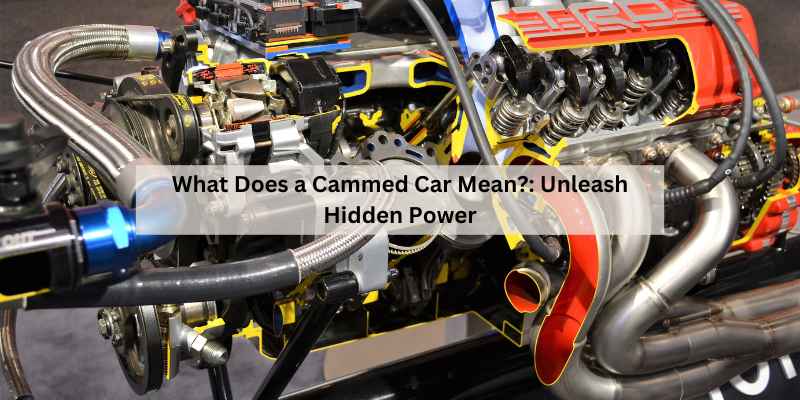What Does a Cammed Car Mean?: Unleash Hidden Power
A cammed car refers to a vehicle with upgraded camshaft components. These modifications enhance engine performance, typically increasing horsepower and torque.
Car enthusiasts often seek ways to boost their vehicle’s performance. One popular modification is installing a camshaft, or “camming” the engine. This change affects how the engine breathes and performs, resulting in a more powerful output. Cams can alter the engine’s timing and lift, allowing for better airflow.
As a result, drivers may experience improved acceleration and throttle response. Cammed cars often produce a distinct sound, attracting attention on the road. Understanding the impact of a cammed engine can help car owners make informed decisions about modifications. This guide will explore the benefits and considerations of camming your car.
Introduction To Cammed Cars
A cammed car has an upgraded camshaft. This part controls the engine’s timing and valve lift. Camming changes how the engine breathes. It can improve power and sound.
Many car enthusiasts choose to cam their vehicles for better performance. A cammed car often has a louder exhaust note. It can make driving more exciting.
Some people enjoy the challenge of tuning their engines. They want to stand out among other cars. A cammed car can show off a driver’s skills and dedication. Camming is a popular way to enhance a vehicle’s character.
Overall, camming provides both fun and performance benefits to car lovers.
The Heart Of The Matter: Camshafts Explained
The camshaft plays a crucial role in an engine’s operation. It controls the timing and movement of the engine’s valves. This helps regulate air and fuel intake. Proper functioning of the camshaft ensures better engine performance.
Camming affects performance by changing how the engine breathes. A cammed car has a modified camshaft. This allows for increased lift and duration of the valves. As a result, the engine can take in more air and fuel. This leads to greater power output and acceleration.
Drivers often notice improved throttle response and a more aggressive sound. However, camming can also impact fuel efficiency. It’s important to balance performance gains with daily driving needs.
Types Of Camshafts
Camshafts are vital for engine performance. They control the opening and closing of engine valves. Two main types of camshafts exist: flat tappet and roller cams.
Flat tappet cams are traditional. They are less expensive but wear out faster. On the other hand, roller cams use small wheels. They reduce friction and last longer.
Choosing the right cam for your vehicle matters. Consider your engine type and driving style. Think about how much power you need. Performance and efficiency are key factors in your decision.
Benefits Of Camming Your Car
Camming your car brings many benefits. One key advantage is increased horsepower and torque. A cammed engine allows for better airflow. This results in more power during acceleration.
Improved throttle response is another benefit of camming. Drivers notice quicker acceleration and better performance. The engine sound also becomes more aggressive and exciting. This enhances the overall driving experience.
Overall, camming a car makes it more fun to drive. These changes can turn a regular vehicle into a thrilling machine.
Considerations Before Camming
Before camming a car, compatibility is crucial. Ensure the camshaft fits your engine. This helps maintain optimal performance. Some cars may need additional modifications. Always check your car’s specifications.
Camming can affect fuel efficiency and emissions. A cammed car might use more fuel. This can lead to higher emissions. Ensure you understand these impacts before proceeding. Consider if the benefits outweigh the drawbacks.
The Camming Process
The camming process involves several steps. It enhances the engine’s performance. Specific tools and parts are necessary for this modification.
Essential tools include a socket set, torque wrench, and screwdrivers. Important parts are a new camshaft, lifters, and valve springs. These components work together to improve engine dynamics.
| Tool/Part | Purpose |
|---|---|
| Socket Set | For removing and installing bolts |
| Torque Wrench | Ensures proper bolt tightness |
| New Camshaft | Increases engine power |
| Lifters | Control valve movement |
| Valve Springs | Maintain valve closure |
Real-world Examples
Many car enthusiasts have shared their experiences with cammed cars. For example, a 2016 Chevrolet Camaro owner reported a 50% boost in horsepower. This change made the car much faster on the track.
Another owner of a Ford Mustang GT mentioned improved throttle response. They felt the car was more fun to drive after adding a camshaft. Owners often highlight the unique sound of a cammed engine. This sound turns heads and draws attention.
| Car Model | Performance Outcome | Owner Testimonial |
|---|---|---|
| Chevrolet Camaro | 50% boost in horsepower | “It’s much faster on the track!” |
| Ford Mustang GT | Improved throttle response | “Driving it is more fun now!” |
Maintaining Your Cammed Car
Routine checks are important for your cammed car. Regularly inspect the engine, exhaust system, and fuel system. Look for any signs of wear or damage. Adjustments may be needed to keep everything running smoothly.
Long-term care requires special attention. Change the oil and filters according to the schedule. Keep the spark plugs in good condition for better performance. Pay attention to coolant levels to avoid overheating. Regular tuning helps maintain optimal power and efficiency.
| Check | Frequency |
|---|---|
| Oil Change | Every 3,000 miles |
| Spark Plug Inspection | Every 30,000 miles |
| Coolant Level Check | Monthly |
| Exhaust System Check | Every 10,000 miles |
Frequently Asked Questions
What Are The Cons Of Camming Your Car?
Camming your car can lead to increased wear on the engine. It may void warranties and reduce fuel efficiency. Legal issues can arise from emissions regulations. Insurance rates might increase due to modifications. Resale value could drop if buyers are wary of performance changes.
How Does A Cam Affect An Engine?
A camshaft controls the timing and duration of valve openings in an engine. It influences performance characteristics like power, torque, and fuel efficiency. Different cam profiles can enhance acceleration or top speed, affecting overall engine behavior and responsiveness. Choosing the right cam is crucial for optimal engine performance.
What Does A Car Cam Do?
A car cam, or dashcam, records video footage while driving. It captures real-time events on the road, providing evidence in case of accidents. This device enhances safety and can deter reckless driving. Users often review footage for insurance claims or legal purposes.
What Does It Mean When A Car Is Cammed Out?
A “cammed out” car has upgraded camshafts, enhancing engine performance. This modification improves horsepower and torque, resulting in a more aggressive sound and better acceleration. Enthusiasts often cam their vehicles for increased power and a sportier driving experience.
Conclusion
A cammed car enhances performance and sound, making it a favorite among car enthusiasts. Understanding its meaning helps you appreciate the modifications that boost horsepower and torque. Whether for racing or daily driving, a cammed engine offers a unique driving experience.
Embrace the thrill and enjoy the ride!







